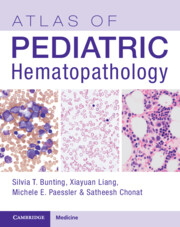Book contents
- Atlas of Pediatric Hematopathology
- Atlas of Pediatric Hematopathology
- Copyright page
- Contents
- Contributors
- Section I Peripheral Blood
- Section II Normal and Non-neoplastic Hematolymphoid Diseases
- Chapter 5 Benign Non-neoplastic Noninfective Lymphadenopathy
- Chapter 6 Normal Bone Marrow Components in Pediatric Patients
- Chapter 7 Infectious Diseases
- Section III Mature Lymphoid Neoplasm
- Section IV Precursor Hematopoietic Neoplasms and Related Neoplasms
- Section V Histiocytic Neoplasm and Miscellaneous Bone Marrow Diseases
- Index
- References
Chapter 5 - Benign Non-neoplastic Noninfective Lymphadenopathy
from Section II - Normal and Non-neoplastic Hematolymphoid Diseases
Published online by Cambridge University Press: 25 November 2023
- Atlas of Pediatric Hematopathology
- Atlas of Pediatric Hematopathology
- Copyright page
- Contents
- Contributors
- Section I Peripheral Blood
- Section II Normal and Non-neoplastic Hematolymphoid Diseases
- Chapter 5 Benign Non-neoplastic Noninfective Lymphadenopathy
- Chapter 6 Normal Bone Marrow Components in Pediatric Patients
- Chapter 7 Infectious Diseases
- Section III Mature Lymphoid Neoplasm
- Section IV Precursor Hematopoietic Neoplasms and Related Neoplasms
- Section V Histiocytic Neoplasm and Miscellaneous Bone Marrow Diseases
- Index
- References
Summary
Lymphadenopathy (LAD) is a common presentation in the pediatric population. Cervical LAD with neck mass is the most common manifestation [1]. The etiology of LAD is diverse, including various benign nonspecific reactive conditions, infections, neoplasms, and immune disorders, among others. In spite of the initial concern of lymphoma or infectious conditions, most cases of LAD turn out to be benign and nonspecific reactive. The morphologic features of nonspecific reactive LAD can overlap with those of specific infective LAD or lymphoma. Although some features are more associated with certain etiologies, they are not pathognomonic. Clinical correlation would be essential on this ground. The goal of this chapter is to use case-based illustration to thoroughly demonstrate the morphological features of reactive lymph node and specific entities of non-neoplastic/noninfective LAD.
- Type
- Chapter
- Information
- Atlas of Pediatric Hematopathology , pp. 31 - 41Publisher: Cambridge University PressPrint publication year: 2023

